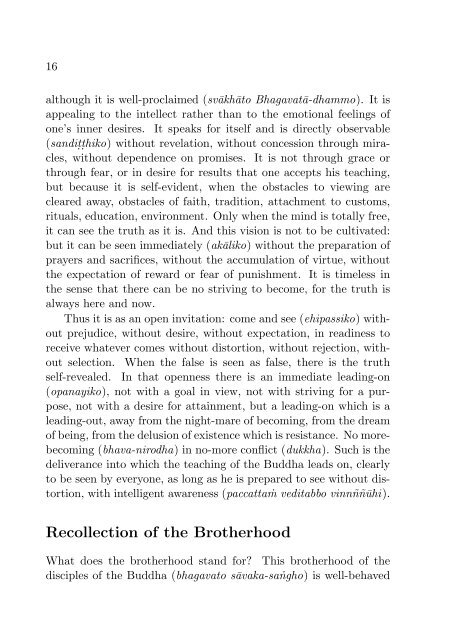Awareness in Buddhist Meditation
A detailed description of awareness in Buddhist Meditation.
A detailed description of awareness in Buddhist Meditation.
Create successful ePaper yourself
Turn your PDF publications into a flip-book with our unique Google optimized e-Paper software.
16<br />
although it is well-proclaimed (svākhāto Bhagavatā-dhammo). It is<br />
appeal<strong>in</strong>g to the <strong>in</strong>tellect rather than to the emotional feel<strong>in</strong>gs of<br />
one’s <strong>in</strong>ner desires. It speaks for itself and is directly observable<br />
(sandiṭṭhiko) without revelation, without concession through miracles,<br />
without dependence on promises. It is not through grace or<br />
through fear, or <strong>in</strong> desire for results that one accepts his teach<strong>in</strong>g,<br />
but because it is self-evident, when the obstacles to view<strong>in</strong>g are<br />
cleared away, obstacles of faith, tradition, attachment to customs,<br />
rituals, education, environment. Only when the m<strong>in</strong>d is totally free,<br />
it can see the truth as it is. And this vision is not to be cultivated:<br />
but it can be seen immediately (akāliko) without the preparation of<br />
prayers and sacrifices, without the accumulation of virtue, without<br />
the expectation of reward or fear of punishment. It is timeless <strong>in</strong><br />
the sense that there can be no striv<strong>in</strong>g to become, for the truth is<br />
always here and now.<br />
Thus it is as an open <strong>in</strong>vitation: come and see (ehipassiko) without<br />
prejudice, without desire, without expectation, <strong>in</strong> read<strong>in</strong>ess to<br />
receive whatever comes without distortion, without rejection, without<br />
selection. When the false is seen as false, there is the truth<br />
self-revealed. In that openness there is an immediate lead<strong>in</strong>g-on<br />
(opanayiko), not with a goal <strong>in</strong> view, not with striv<strong>in</strong>g for a purpose,<br />
not with a desire for atta<strong>in</strong>ment, but a lead<strong>in</strong>g-on which is a<br />
lead<strong>in</strong>g-out, away from the night-mare of becom<strong>in</strong>g, from the dream<br />
of be<strong>in</strong>g, from the delusion of existence which is resistance. No morebecom<strong>in</strong>g<br />
(bhava-nirodha) <strong>in</strong> no-more conflict (dukkha). Such is the<br />
deliverance <strong>in</strong>to which the teach<strong>in</strong>g of the Buddha leads on, clearly<br />
to be seen by everyone, as long as he is prepared to see without distortion,<br />
with <strong>in</strong>telligent awareness (paccattaṁ veditabbo v<strong>in</strong>nññūhi).<br />
Recollection of the Brotherhood<br />
What does the brotherhood stand for? This brotherhood of the<br />
disciples of the Buddha (bhagavato sāvaka-saṅgho) is well-behaved

















